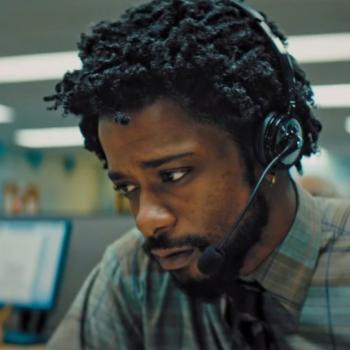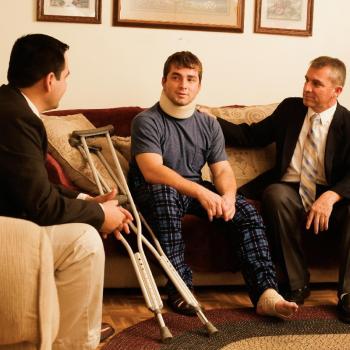I am an independent scholar. Not independently wealthy unfortunately – I have to earn my bread – but I am one of the growing number of people with PhDs who, for a wide variety of reasons, are not pursuing a traditional career track of teaching and scholarship, but rather have day jobs that variously engage our talents – academic and otherwise – while we continue to engage in the life of the mind on our own terms.
I’ve only been on this path for a little over two years, since earning my PhD in 2011. I’m still figuring out how this works for me. And part of the process for me has been to explore different venues in which to meet other scholars, share more or less developed ideas, and disseminate scholarship. I have taken up blogging. I attend a regular colloquium of scholars in my field who gather biweekly to workshop one another’s work in progress. I avail myself of the wealth of lectures and presentations that abound in my home, the Boston-area. And I have been trying out different conferences and symposia, large and small, to see where I get the most bang for my buck. (I mean that quite literally. I’m not only concerned about my time, which is valuable enough since I often have to put in for vacation to attend these things. I’m talking about my money—my 9-to-5 doesn’t come with research funding.) In the last three years I have attended the annual conferences of large international scholarly organizations and regional offshoots of the same; I have participated in smaller conferences aimed at specialists in particular subfields; and, on my most recent adventure, I accepted an invitation to speak at a small symposium designed not to advance new scholarship but rather to disseminate existing scholarship to a non-academic audience: secondary school teachers. And you know what? It was well worth my while.
When I was invited to join the symposium, just ten days ago, I honestly didn’t know what to make of it. The event was the capstone of a year-long exploration in Illinois of Joseph Smith and the right of habeas corpus. Over the course of the last year, “Joseph Smith Captured!” brought together scholars, teachers, government officials, and the public for reenactments of some of Joseph Smith’s trials in Illinois, for tours and discussions at the historic Mormon city of Nauvoo, and finally for this three-day gathering at the Abraham Lincoln Presidential Library and Museum in Springfield, Illinois. A group of scholars from a variety of organizations were brought in to present on various issues relating to civil liberties in the United States; the rights and experiences of minorities; and the right of habeas corpus as it has been variously applied and interpreted in American history, from Joseph Smith to Abraham Lincoln to Guantanamo Bay; and, given the focus on Joseph Smith and his followers, the history of the Mormons and their many religious cousins in the United States. (I was there, not surprisingly, to talk about the Book of Mormon on Broadway and contemporary American perceptions of the Latter-day Saints.) The goal, for our audience of public school teachers and administrators from across the state of Illinois, was to incorporate these diverse and often troubling elements of Illinois’s and America’s history into a curriculum that would encourage students to go beyond the historical facts to discuss issues of American law, individual and community rights, and justice.
I got a couple of things out of this experience.
First, I got to see scholars and teachers and purveyors of public history—Mormon Studies AND non-Mormon Studies people—putting Mormon history into a much broader context by analyzing it alongside of and intertwined with other aspects of American history. Mormon Studies—like any form of minority studies—does not exist in a vacuum. Just as American history is incomplete without a full and rich discussion of the actions, contributions, experiences, and sufferings of its minorities—much as I love him, Sydney Ahlstrom is not enough—Mormon Studies cannot produce a fully realized story of the Latter-day Saints without embedding its subjects in the history and the non-Mormon communities that surround(ed) them.
Second, the middle and high school teachers we were there to talk to will, I hope, return to their social studies and government and language arts classrooms and teach their students something about how Joseph Smith and the Mormons fit into the bigger picture of American history. How what Americans said and did (and say and do) in response to the Mormons isn’t just about the Mormons, but rather is about how we Americans—we human beings—treat “others” and whether or not we really respect their rights as we do our own. How rights aren’t guaranteed and the ideals enshrined in our founding documents aren’t always achieved—nor is it always clear how they apply. How tolerance toward people with very different values from your own isn’t easy, but it’s a problem worth struggling with. How we have to be attentive to the rights of others as well as our own, or nobody’s rights will be respected.
This was not a scholarly conference, despite the wealth of scholars present, and I knew it going in. A few people even hinted that this was going to be a waste of my time precisely because the point wasn’t for a bunch of academics to sit around presenting new scholarship to other members of our tribe. But here’s the thing: We scholars were there to share the knowledge we’ve earned through years of hard work and egg-headedness with what I hope will eventually be a much broader audience of people for whom these issues aren’t about academic abstractions, but rather about living their lives on a day-to-day basis. Isn’t that what scholarship is really all about in some fundamental way? Or, if it’s not, shouldn’t it be?
I think my time and intellectual energy were well spent this weekend. This experiment was a success.











